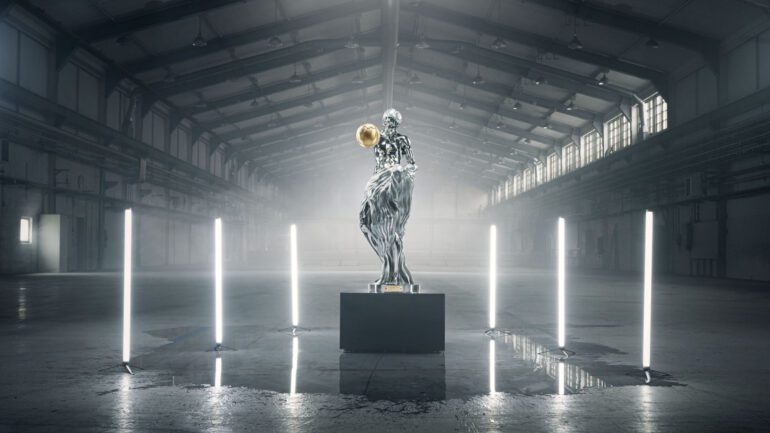TL;DR:
- Stockholm’s Science and Technology Museum unveils “The Impossible Statue,” a remarkable fusion of generative AI and precision manufacturing.
- The statue, created through a collaboration between The AI Framework and Sandvik, showcases the potential of computer-programmed manufacturing.
- AI models were trained on the works of renowned sculptors to create a unique designs combining different artistic attributes.
- The statue defies gravity, with an androgynous figure composed of shifting shades of steel holding a globe entangled in a wavy metal sheet.
- Sandvik converted the 2D image into a precise 3D model, optimizing the manufacturing process and reducing steel usage by half.
- The final statue exhibits extraordinary craftsmanship, deviating from the digital design by less than 0.03 mm.
Main AI News:
The latest addition to Stockholm’s Science and Technology Museum has garnered attention and curiosity from visitors. At first glance, the statue may appear unremarkable—a human-shaped swirl of stainless steel holding an orb reminiscent of an oversized awards trophy. However, upon closer inspection, the true uniqueness of this five-foot masterpiece becomes apparent: it is the result of a groundbreaking fusion of generative AI and precision manufacturing.
Dubbed “The Impossible Statue,” the title is far from hyperbolic, given the underlying concept and painstaking design process involved in its creation. The collaborative effort between The AI Framework, a renowned consultancy, and Sandvik, an engineering firm specializing in metal-cutting, has showcased the remarkable capabilities of computer-programmed manufacturing.
While this project revolves around art, the manufacturing methods employed in crafting The Impossible Statue closely resemble those used in other industrial tasks. Nadine Crauwels, president of Sandvik Machining Solutions, emphasized, “By leveraging our comprehensive capabilities, we can significantly enhance manufacturing efficiency, minimize waste, and ensure unparalleled quality.”
The journey began by training AI models on the artistic works of five esteemed sculptors. The Sandvik team meticulously blended together the contrapposto of Michelangelo, the musculature of Rodin, the naturalism of Käthe Kollwitz, the dynamic movement of Takamura Kotaro (a devoted follower of Rodin), and the boldness exemplified in Augusta Savage’s figures. They cherry-picked the most desirable attributes from these celebrated sculptors spanning five centuries and utilized a combination of Stable Diffusion, DALL-E, and Midjourney algorithms to generate images repeatedly until their vision was fully realized.
The result is an androgynous figure crafted from a harmonious interplay of shifting shades of steel, cradling a globe that defies gravity. Its lower half is entangled in a sinuous sheet of metal, an intriguing display of craftsmanship. Do the invisible hands of the aforementioned sculptors reveal themselves in the final creation? To some extent, the musculature undoubtedly possesses boldness, while the fabric exhibits a contemporary reinterpretation of Renaissance aesthetics. Yet, the darker social commentaries often found in the works of Kollwitz and Savage seem absent in this statue, which brims with untapped potential and promise.
Having settled on the design, Sandvik proceeded to convert the 2D image into a meticulously detailed 3D model. This transformation was achieved using depth-estimator software and human pose estimation, a computer-based technique that identifies different parts of the human body within a given scene. The company subjected the manufacturing process to a series of rigorous digital simulations, effectively halving the amount of steel required. The final statue comprised nine million polygons and 17 distinct steel pieces, deviating from the digital design by a mere 0.03 mm.
Peter Skogh, the director of the Science and Technology Museum, expressed his enthusiasm for the project, stating, “The Impossible Statue is a remarkable testament to the incredible possibilities that emerge from the intersection of modern technology and human ingenuity. Our mission is to foster a broader understanding of technology’s potential and inspire the next generation. This project effortlessly aligns with our objectives, ticking all the boxes.”
In an era where artistry and innovation intertwine, The Impossible Statue serves as a vivid illustration of what can be achieved through the harmonious collaboration of cutting-edge technology and human brilliance. Its presence within the museum not only captivates audiences but also sparks a profound appreciation for the boundless possibilities that lie at the nexus of creativity and technological advancement.
Conlcusion:
“The Impossible Statue” exemplifies the remarkable synergy between modern technology and human brilliance. This breakthrough in generative AI and precision manufacturing not only showcases artistic creativity but also holds significant implications for the market. The collaboration between The AI Framework and Sandvik highlights the potential for improved manufacturing efficiency, reduced waste, and exceptional quality across various industries. This project paves the way for further exploration of the possibilities and advancements in computer-programmed manufacturing, inspiring the next generation and igniting the imagination of those seeking the intersection of artistry and innovation.

